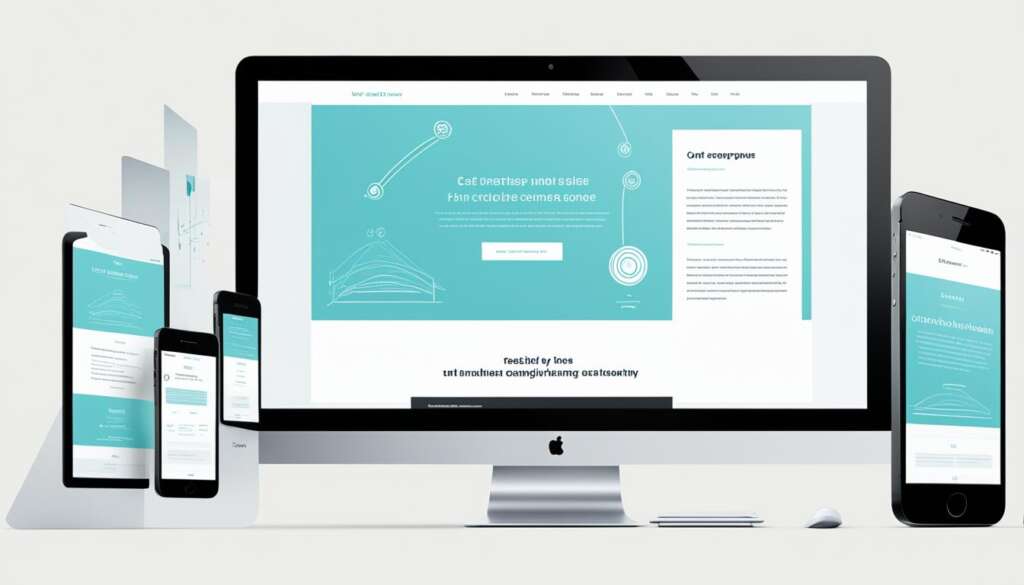Table of Contents
Responsive design principles are essential for creating websites that provide an optimal user experience across devices. With the ever-growing variety of devices and screen sizes, it is crucial to ensure that websites can adapt and respond to the different needs of users. Whether they are browsing on a smartphone, tablet, or desktop computer, responsive design allows websites to seamlessly adjust and provide a cohesive online experience.
Responsive design addresses the challenge of device-switching by using a fluid approach to web design. This approach allows websites to fluidly scale and rearrange elements based on the screen size and resolution, ensuring that the content remains accessible and readable. It not only enhances user experience but also plays a crucial role in search engine optimization (SEO) by creating websites that are easy to navigate and index by search engines.
In his book, Responsive Web Design, web designer Ethan Marcotte first coined the term “responsive design.” He introduced three main principles to guide the development of responsive websites: fluid grid systems, fluid image use, and media queries. These principles provide the foundation for building websites that are adaptable, visually appealing, and accessible.
By applying fluid grid systems, designers can create layouts that adjust proportionally to different screen sizes. This ensures that the website’s structure remains consistent and visually pleasing across devices. Additionally, fluid image use involves optimizing images to adapt and fit within the available screen real estate, without compromising quality or load times. Media queries allow designers to apply different styles and layout rules based on specific device characteristics, providing targeted experiences for users accessing websites from various devices.
Implementing the principles of responsive design is crucial for creating user-centric websites that prioritize optimal functionality and accessibility. Responsive design ensures that regardless of the device used, users can easily access and navigate through websites, leading to a more engaging and satisfying online experience.
What is Responsive Design?
Responsive web design is an approach to designing web content that allows it to appear regardless of the resolution governed by the device. It uses viewport breakpoints and rules for content flow and layout changes based on screen size. Responsive design ensures that websites can adjust and respond to different device resolutions, providing a consistent user experience across devices. It is the default approach for supporting device-switching and is crucial for creating responsive sites.
Responsive design is founded on the idea that websites should be accessible and user-friendly across various devices, including desktops, laptops, tablets, and smartphones. By adopting a responsive approach, designers can create flexible websites that adapt to different screen sizes and orientations, guaranteeing an optimal viewing experience for users.
The core principle of responsive design is the use of fluid grids, where the layout and elements of a webpage are defined in terms of relative proportions rather than fixed pixels. This allows the content to resize and reposition dynamically based on the screen size, ensuring that the website looks and functions well on any device.
The use of media queries is another key aspect of responsive design. Media queries allow designers to define CSS rules that respond to different conditions, such as screen width, orientation, and pixel density. By utilizing media queries, designers can apply specific styles and layouts to different devices, ensuring that the website adapts seamlessly to each user’s browsing environment.
Responsive web design also involves the implementation of flexible images. Images that are designed responsively adjust their size and resolution based on the available screen space, ensuring they remain sharp and visually appealing across different devices. By optimizing images for responsiveness, websites can achieve faster loading times and improved performance.
Overall, responsive web design is an essential approach for creating modern and user-friendly websites. By prioritizing responsiveness, designers can ensure that web content is accessible, engaging, and seamlessly adapts to the ever-changing landscape of devices and user preferences.
| Advantages of Responsive Design | Disadvantages of Non-Responsive Design |
|---|---|
|
|
The 3 Major Principles of Responsive Design
The three major principles of responsive design are fluid grid systems, fluid image use, and media queries. These principles form the foundation of responsive design, allowing websites to adapt and respond to different screen sizes and orientations.
Fluid Grid Systems
One of the key principles in responsive design is the use of fluid grid systems. Instead of relying on absolute measurements, fluid grids use relative sizes to ensure that the layout adjusts dynamically based on the user’s screen size. This allows for a seamless user experience across devices. By defining columns and rows using percentages rather than fixed pixels, elements within the grid can automatically resize and rearrange themselves to fit different screen sizes.
Fluid Image Use
In addition to fluid grid systems, fluid image use is another essential principle in responsive design. By resizing images based on available screen real estate using percentage dimensions and the max-width property, websites can optimize the display of images on different devices. This ensures that images remain clear and proportional, regardless of the screen size, creating a visually appealing experience for users.
Media Queries
The final principle of responsive design is the use of media queries. Media queries allow designers to apply different styles and layouts based on the characteristics of the user’s device, such as screen width, resolution, or orientation. By utilizing media queries, websites can adapt their design to provide an optimal viewing experience on various devices. This includes adjusting font sizes, hiding or displaying content, and repositioning elements to ensure readability and usability.
“Responsive design is all about creating a harmonious user experience across devices, and fluid grid systems, fluid image use, and media queries play a vital role in achieving this goal.”
– Mark Smith, Lead Web Designer
| Principles | Description |
|---|---|
| Fluid Grid Systems | Use relative sizes to adapt layouts based on screen sizes, ensuring a consistent experience. |
| Fluid Image Use | Resize images proportionally to fit different screen sizes, maintaining visual clarity. |
| Media Queries | Apply different styles and layouts based on device characteristics, enhancing usability. |
Best Practices for Responsive Design
In order to create responsive and user-friendly websites, it is important to follow best practices for responsive design. By adopting a mobile-first approach, designing fluid grids and images, prioritizing the use of scalable vector graphics (SVGs), and focusing on content prioritization, accessibility, and minimalism, designers can ensure flexibility and optimal user experiences across different devices.
Mobile-First Approach
Adopting a mobile-first approach means designing websites with mobile devices in mind first and then scaling up to larger screens. This approach recognizes the increasing use of mobile devices for internet browsing and emphasizes the importance of delivering a seamless experience to mobile users. By starting with a mobile-first approach, designers can prioritize essential content and ensure that the website is optimized for smaller screens.
Fluid Grids and Images
Designing fluid grids and images is essential to create responsive websites. A fluid grid system uses relative measurements instead of fixed ones, allowing the design to adapt to different screen sizes and orientations. This ensures that the layout remains flexible and adjusts accordingly. Similarly, using fluid images with percentage dimensions and the max-width property allows them to resize based on available screen real estate, preventing them from being too large or small on different devices.
Scalable Vector Graphics (SVGs)
Scalable vector graphics (SVGs) are graphics that can be scaled up or down without losing quality. This makes them ideal for responsive design, as they can adapt to different screen sizes while maintaining their clarity and sharpness. By prioritizing the use of SVGs over raster images, designers can ensure that the visual elements of their websites look great on any type of device.
Content Prioritization
Content prioritization is a crucial aspect of responsive design. It involves analyzing and understanding the different user contexts and prioritizing content accordingly. By identifying the most important information and presenting it prominently, designers can ensure that users can easily find what they’re looking for, regardless of the device they’re using. This improves the overall user experience and helps users achieve their goals more efficiently.
Minimalism
Minimalism is a design principle that emphasizes simplicity and clarity. By applying a minimalist approach to responsive design, designers can create clean and uncluttered websites that are visually appealing and easy to navigate. Removing unnecessary elements and focusing on essential content enhances the user experience and ensures that the website remains accessible and functional across different devices.
Accessibility
Accessibility should be a top priority when designing responsive websites. This involves ensuring that all users, regardless of their abilities or limitations, can access and navigate the website easily. By following accessibility guidelines and implementing features such as proper heading structure, descriptive alt tags for images, and keyboard navigation support, designers can make their websites inclusive and usable for all users.
By following these best practices, designers can create responsive websites that deliver optimal user experiences and adapt seamlessly to different devices. Prioritizing a mobile-first approach, designing fluid grids and images, utilizing scalable vector graphics, prioritizing content, embracing minimalism, and focusing on accessibility are essential steps towards achieving responsive and user-friendly designs.
Conclusion
Responsive web design is an essential discipline in the realm of digital design. It ensures that websites adapt and respond to different screen sizes and orientations, providing optimal functionality and aesthetics. By embracing principles such as fluid layouts, responsive units, flexible images, and media queries, designers can create websites that seamlessly adapt to the diverse landscape of devices and user behaviors.
The art of responsive web design lies in striking a balance between aesthetics and functionality, ultimately delivering a cohesive online experience for users. Websites that are visually appealing and easy to navigate ensure an optimal user-centric design. By prioritizing accessibility and user experience, responsive web design aims to create websites that are inclusive and engaging for all audiences.
From fluid grid systems to scalable vector graphics, responsive web design empowers designers to create websites that not only look great but also function seamlessly on all devices. The ability to adapt to the varying screen sizes and orientations ensures optimal functionality and provides users with a cohesive online experience. Ultimately, responsive web design is a crucial aspect of modern web development, enabling websites to deliver optimal performance, engage users, and establish a strong online presence.
FAQ
What is responsive design?
Responsive design is an approach to designing web content that allows it to appear regardless of the resolution governed by the device. It uses viewport breakpoints and rules for content flow and layout changes based on screen size.
What are the main principles of responsive design?
The main principles of responsive design include fluid grid systems, fluid image use, and media queries. Fluid grid systems use relative sizes instead of absolute measurements to ensure that the layout adapts to different screen sizes. Fluid image use involves resizing images based on screen real estate using percentage dimensions and the max-width property. Media queries allow designers to apply different styles based on device characteristics, such as screen width and orientation.
Why is responsive design important?
Responsive design is crucial for accessibility and search engine optimization (SEO). It ensures that websites can adjust and respond to different device resolutions, providing a consistent user experience across devices. It is the default approach for supporting device-switching and is crucial for creating responsive sites.
What are the best practices for responsive design?
Best practices for responsive design include adopting a mobile-first approach, designing fluid grids and images, prioritizing the use of scalable vector graphics (SVGs), and prioritizing and hiding content to suit user contexts. Other best practices include aiming for minimalism, applying design patterns to enhance ease of use, and prioritizing accessibility. These practices ensure flexibility in every aspect of the design and create responsive and user-friendly websites.
Why is responsive web design important?
Responsive web design is an essential discipline in the realm of digital design. It ensures that websites adapt and respond to different screen sizes and orientations, providing optimal functionality and aesthetics. By embracing principles such as fluid layouts, responsive units, flexible images, and media queries, designers can create websites that seamlessly adapt to the diverse landscape of devices and user behaviors. The art of responsive web design lies in striking a balance between aesthetics and functionality, ultimately delivering accessible, engaging, and user-centric websites.













